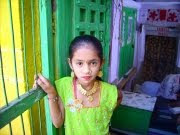
In a world where everything has a price, hair does not only represent the richest ornament of women but also a luxury good. Hair India tells the story of the cult of beauty in the new era of globalisation, says ADELINE BERTIN
For hundreds of years, devotees have donated money or jewellery to temples, while others offer the only thing they own: their hair. Italian directors Raffaele Brunetti and Marco Leopardi’s documentary, Hair India (2008), tells the fascinating story of a young Indian woman’s hair.
The two Italian directors discovered that, every day, 40,000 pilgrims donate their hair in a ritual of purification. Until recently, hair offered to Hindu temples was usually swept up and burned or used to stuff mattresses. However today, it has become an extraordinary economic resource, sold for $100,000 U.S. per 400 kilograms all over the world.
Structured on an alternate editing, four stories develop in parallel. We follow the product’s transformations from Hemlata’s devout and poor Hindu family from Muchipara (West Bengal) who donate their hair, to Bangalore-based wholesale hair dealer Mayoor Balsara. From there, the hair is sent to Thomas Gold, owner of “Great Lengths,” the Italian world’s leading manufacturer of hair extensions. The final destination is the salon of Mumbai-based famous hairdresser Dilshad, where glamorous executive editor of the fashion magazine Hello!, Sangeeta, buys expensive extensions to attend an extraordinary fashion parade.
For the two Italian directors, following the thirty-thousand-kilometres journey of a lock of hair allowed them to penetrate the contradictions of modern India. “The development of high technology and the steady growth of industry are producing wealth and well-being but generate tensions between the old and the new,” analyses Raffaele Brunetti.
With Leopardi, he immediately liked Hemlata’s village: “It is a perfect example of the non-developed part of the country which is “watching” the developing India,” explains Brunetti. The inhabitants indeed constantly look at cars and trucks transporting a huge amount of goods on the highway next to Muchipara.
Not surprisingly, the journey of one month in India with the rest of the crew consisted for the Italian duo a very special and challenging moment: “Even though it was a long and exhausting trip, right after the ritual was completed, we really saw the family going through a transformation. It was very special. All the tension was gone,” remembers Raffaele Brunetti.
Moreover, the possibility to live in close contact with so different realities was an unexpected strong and moving human experience. “The great humanity that reigns in this place cannot be found in any other places in the world,” declares Brunetti.
For his co-director, the documentary gives everybody the chance to reflect upon several things. “The most evident is the curious trade of hair. A second level is represented by the concept of beauty, as it is conceived in the different cultures and social ranks,” points out Marco Leopardi.
In Hair India, it assumes different values as it goes along. Hemlata may have lost her external beauty, but has no doubts: now her spirit is pure. “The most intimate beauty has thus been achieved” assumes Leopardi. In parallel, Dilshad applies to Sangeeta the extensions since the wealthy woman wants to be more attractive and accepted by the Indian elite. However for Leopardi: “Her melancholic eyes reveal her sadness. Maybe she is aware that she belongs to a world in which the values have lost their reference points.”
In Good Hair, Chris Rock’s new documentary, we explore the insights of the African-American hair culture and discover that most of African-American women feel they need long, silky, straight hair to fit into white society. The funny man reflects upon the importance and meaning of the black material, hugely exported from India, after her little daughter Lola asked him, crying, how come she does not have “good hair”.
What the two documentaries interestingly try to convey is that everybody should not get lost in the disparities of a society torn between modernity and its commitment to ancient traditions; that what is on top of our heads, may it be called capelli, cheveux or bal, is nowhere near as important as what is inside.

